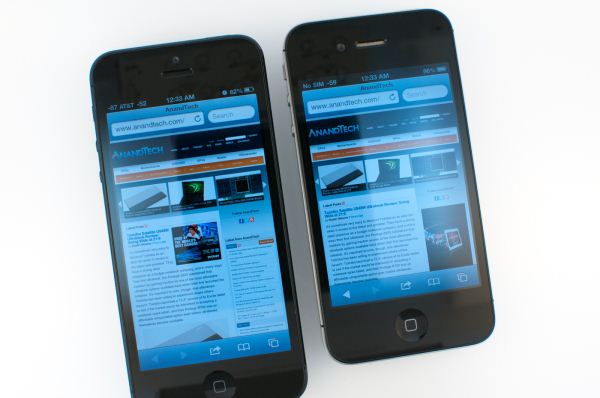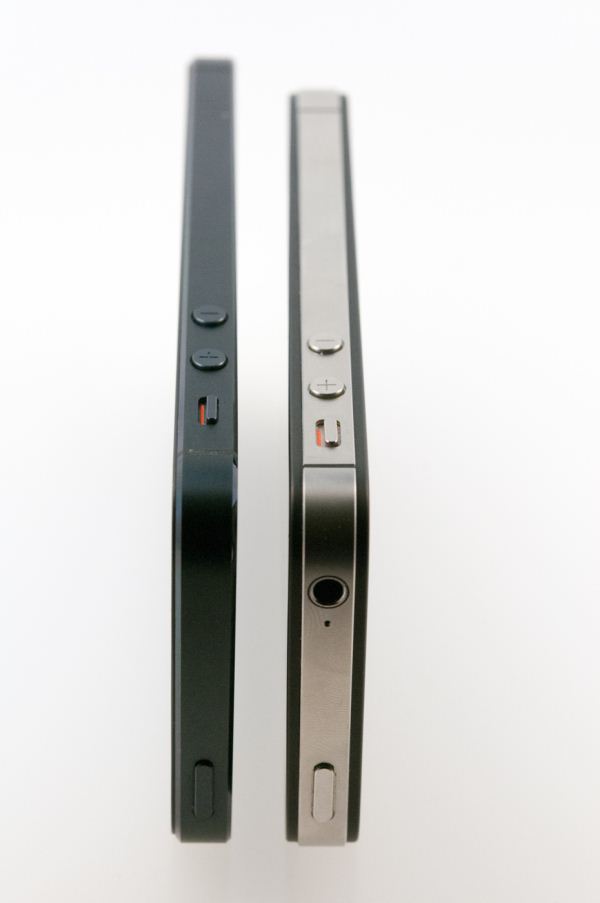The iPhone 5 Review
by Anand Lal Shimpi, Brian Klug & Vivek Gowri on October 16, 2012 11:33 AM EST- Posted in
- Smartphones
- Apple
- Mobile
- iPhone 5
The last significant redesign of the iPhone platform came in 2010 with the iPhone 4. It was an update that literally touched all aspects of the device, from SoC to display to baseband and of course, chassis. Last month’s launch of the iPhone 5 is no different in magnitude. The sixth generation iPhone makes some of the biggest changes to the platform since its introduction in 2007.
Visually the device begins by evolving the design language of the iPhone 4/4S chassis. From the launch of the iPhone 4 it was quite obvious that Apple had picked a design it was quite proud of. Thus it’s not too surprising that, from a distance, the iPhone 5 resembles the previous two iPhone models. We’ll get into material differences shortly, but what make the iPhone 5 design such a radical departure is its larger display.
All previous iPhones have maintained the same 3.5-inch, 3:2 aspect ratio display. With the rest of the world quickly moving to much larger displays, and with 16:9 the clear aspect ratio of choice, when faced with the decision of modernizing the iPhone platform the choice was obvious.
The iPhone 5 embraces a taller, 4-inch, 16:9 1136 x 640 display opting to lengthen the device instead of increasing its area in both dimensions. The result is a device that is distinctly an iPhone, albeit a modern one. The taller display doesn’t do much to make desktop web pages any easier to read as a result of the width staying the same. Those longing for an HTC One X or Galaxy S 3 sized device running iOS are out of luck. Reading emails and typing are both improved though as there’s now more room for lists and the keyboard no longer occupies as much of the display. The taller device can be more awkward to use if you have smaller hands, but the added screen real estate is honestly worth it. Once you get used to the iPhone 5’s display, going back to the older models is tough.
The taller chassis went on a diet as well. The iPhone 5 is now considerably thinner and lighter than its predecessor, which is yet another factor that contributes to it feeling more modern.
Internally the device changes are just as significant, if not more, than those on the outside. The iPhone 5 includes LTE support, which in areas where LTE networks are deployed can be enough reason alone to warrant an upgrade.
The iPhone 5 also includes a brand new SoC from Apple: the A6. For the first time since the introduction of the iPad, Apple has introduced a major branded SoC on an iPhone first. The iPhone 4 used the A4 after it debuted on the iPad, and the 4S picked up the A5 months after the iPad 2 launched with it. The A6 however arrives first on the iPhone 5, and with it comes two of Apple’s first, custom designed CPU cores. We’ve always known Apple as a vertically integrated device and software vendor, but getting into CPU design takes that to a new level.
| Physical Comparison | ||||
| Apple iPhone 4S | Samsung Galaxy S 3 (USA) | HTC One S | Apple iPhone 5 | |
| Height | 115.2 mm (4.5") | 136.6 mm (5.38" ) | 130.9 mm (5.15" ) | 123.8 mm (4.87") |
| Width | 58.6 mm (2.31") | 70.6 mm (2.78") | 65 mm (2.56") | 58.6 mm (2.31") |
| Depth | 9.3 mm ( 0.37") | 8.6 mm (0.34") | 7.8 mm (0.31") | 7.6 mm (0.30") |
| Weight | 140 g (4.9 oz) | 133g (4.7 oz) | 119.5g (4.21 oz) | 112 g (3.95 oz) |
| CPU | Apple A5 @ ~800MHz Dual Core Cortex A9 | 1.5 GHz MSM8960 Dual Core Krait | 1.5 GHz MSM8260A Dual Core Krait | 1.3 GHz Apple A6 (Dual Core Apple Swift) |
| GPU | PowerVR SGX 543MP2 | Adreno 225 | Adreno 225 | PowerVR SGX 543MP3 |
| RAM | 512MB LPDDR2-800 | 2 GB LPDDR2 | 1 GB LPDDR2 | 1 GB LPDDR2 |
| NAND | 16GB, 32GB or 64GB integrated | 16/32 GB NAND with up to 64 GB microSDXC | 16 GB NAND | 16, 32, or 64 GB integrated |
| Camera | 8 MP with LED Flash + Front Facing Camera | 8 MP with LED Flash + 1.9 MP front facing | 8 MP with LED Flash + VGA front facing | 8 MP with LED Flash + 1.2MP front facing |
| Screen | 3.5" 960 x 640 LED backlit LCD | 4.8" 1280x720 HD SAMOLED | 4.3" 960x540 Super AMOLED | 4" 1136 x 640 LED backlit LCD |
| Battery | Internal 5.3 Whr | Removable 7.98 Whr | Removable 6.1 Whr | Internal 5.45 Whr |
There’s a lot to talk about when it comes to the new iPhone. Whether it is understanding the architecture of the A6 SoC or investigating the improved low light performance of the iPhone 5’s rear facing camera, we’ve got it here in what is easily our most in-depth iPhone review to date. Let’s get started.












276 Comments
View All Comments
mykebrian - Thursday, October 18, 2012 - link
is motorola razr i same price with iphone 5?Death666Angel - Thursday, October 18, 2012 - link
"By controlling its own SoC destiny it could achieve a level of vertical integration that no OEM has enjoyed in recent history."I would argue that Samsung enjoys a similar level of vertical integration. They trade the OS-stuff for some fabs. Not sure which can be more profitable. But other than that, they are very much like Apple in terms of vertical smartphone integration I think. :)
iwod - Thursday, October 18, 2012 - link
Any Reason Why Front Camera not using High Profile When Recording Video? It could have saved yet another bit of space with MUCH better quality then baseline.And do Apple offically support play back of H.264 High Profile Video Clip yet?
Spunjji - Friday, October 19, 2012 - link
I very much appreciated the details on the SoC design. Your attempts to refine your battery life analysis were also appreciated, as these do seem to better reflect real-world usage. In general this article was well-researched, well-written and very informative.Unfortunately, the section on the anodization process does end up reading like one big apology. The matter is explained in detail but it's done with an air of resignation, as if this were the only option available to Apple. The fact is that they could have retained some additional girth (whilst still losing some) and had a device with good handling, good aesthetics and superior durability. No comparison to competing devices is made whatsoever, so we have no idea based on your article alone if this really is unavoidable or just poor choice of materials.
The same goes for the part about the camera flare. Is a short comparison with a few relevant models too much to ask? The problem is that (like the previous criticism) I already know how this comes out and it doesn't look very good for Apple.
So there are hundreds of hours spent testing comparative performance and battery life where Apple win, yet no time at all dedicated to comparative analysis where they do not look so good. That starts to look upsettingly like bias. I hope that isn't the case but based on other areas (notebook reviews in particular) it starts to feel like a theme.
Anandtech, as a site I love your tech journalism, but the personal preferences of the writers need to stay at home (or firmly in editorials).
Slaanesh - Friday, October 19, 2012 - link
Couldn't agree more.Krysto - Friday, October 19, 2012 - link
I have to agree. Through out the article, you almost got the impression of worship from the writers, and they've only focused on what Apple did right and how much better that was than their competitors.And what's with all the going back to history of Apple's devices? Was that really necessary for a phone review? Should we expect this for all new iPhones...or for all new Galaxy S devices? I think that part alone shows bias.
And was 50 page review (or whatever it is) really necessary and to wait a month and a half after the product launch? The reason I'm asking is because I know they will never repeat this for any other non-Apple product. But I also think it's kind of pointless, and reviews need to appear max 1 week after the product launches. Maybe two. More than that is really pointless, and it's already obvious in the review that half of it is about how awesome Apple were in the past and still are, and only the other half goes down to the analysis.
dyc4ha - Saturday, October 20, 2012 - link
+1Klugfan - Friday, October 19, 2012 - link
Does everyone remember Edward Tufte's complaints about the iPhone 4 design?If I wasn't concerned about impact on the antenna performance, I'd be tempted to take some fine grit sandpaper to my black iPhone 5, and round off the edges a little. Believe it.
If your biggest concern about phones _really_ is resale value, well the iPhone 5 will do fine, with or without scuffs. If your biggest concern about brain phones is what they look like to other people who see you using them, well, first you're an idiot, and second the iPhone 5 really will do fine there, with or without scuffs.
Does my phone make me look smug? Whatever shall I do.
Hxx - Friday, October 19, 2012 - link
got this phone close to release day and I'm throughly impressed with it. Coming from a droid incredible 2 who crapped out on me 10 months after purchase (the memory slot broke and lost all my pics, videos etc - not fun) I gotta say this is my first interaction with an iOS powered device and so far i love it. I think most Apple products are overpriced (hence the reason why i never got one) but this phone is a beauty for $199 given that i paid almost just as much 1 year ago for my droid phone. A huge thank you to Anandtech for providing such detailed review. Although i may never need as much detail about a phone :-), its nice to know i can always rely on you guys if I ever have any technical questions.Good job Guys!
ol1bit - Friday, October 19, 2012 - link
As always, Anandtech gets into the details I didn't even know I wanted to read about!I'm not an apple product owner, and never plan to be, but it really appears to be a great phone.
Keep up the good work!